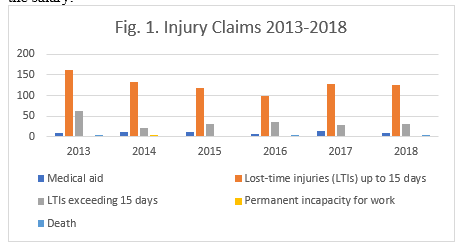BRAZILIAN AQUACULTURE: TOWARDS IMPROVED SURVEILLANCE, REGULATION AND MANAGEMENT OF WORKER HEALTH AND SAFETY
In Brazil, all work accidents or illnesses related to work are supposed to be reported to the government for the purpose of guaranteeing access to benefits and protecting labor rights. Based on these reports, between 2013 and 2018, there were 1053 injury-claim in Brazilian aquaculture, of which 57 were for medical aid; 768 for lost-time injuries (LTIs) up to 15 days; 206 for LTIs exceeding 15 days and 9 permanent incapacity for work (fig. 1). The total number of fatal injuries between 2013 and 2018 was 13. As is the situation elsewhere, there is likely underreporting in the official statistical data for aquaculture. Brazilian workers who have an Employment and Social Security Record Booklet and contribute to social security are entitled to benefits related to an injury or an occupational illness. This benefit is granted by the government to those who are injured or made ill by their work and to the families of those killed at work, with an accepted claim for those who are unable to work for more than 15 consecutive days. In the first 15 days away from work, the company is responsible for paying the salary.
Social charges and taxes continue to be paid by the employer during the entire period of absence due to an injury at work. Currently, Brazilian regulatory standards are contained in texts designed to cover other rural sectors and pay little explicit attention to occupational health in aquaculture. This has a major impact on the effectiveness of worker protection measures, as well as on the ability to collect and monitor statistical data on injuries, fatalities and occupational diseases. This is because, contrary to what happens in regulations for other sectors, aquaculture does not have regulations that provide clear rules regarding worker safety and prevention. Brazil needs a greater commitment to OSH to improve and implement regulations. This requires an integrated system prioritizing prevention and using data on injuries and illnesses to help identify the most effective preventative measures available in the country. This could be done by a) establishing specific public policies and regulations for aquaculture OSH and b) providing training to collect accurate information on AOSH, as well as making that information available to regulators and others. Other alternatives would be c) to implement management systems and certifications that will ensure better OSH. External and internal audits, as well as inspections to promote the education and awareness of employers and workers, based on continuous quality assurance would also help. Taken together this collection of initiatives would support the development of a management model based on the One Health approach
